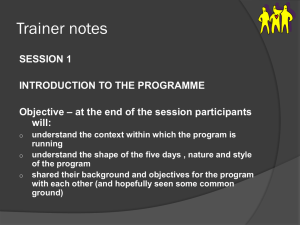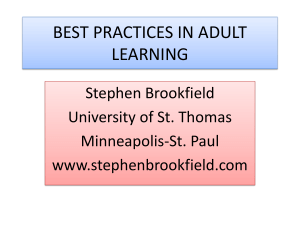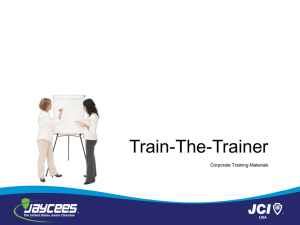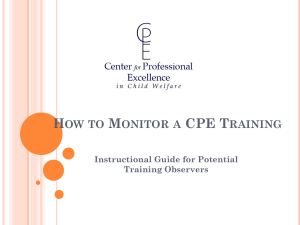Instructional Methods: Advantages and Possible - I-Tech
advertisement
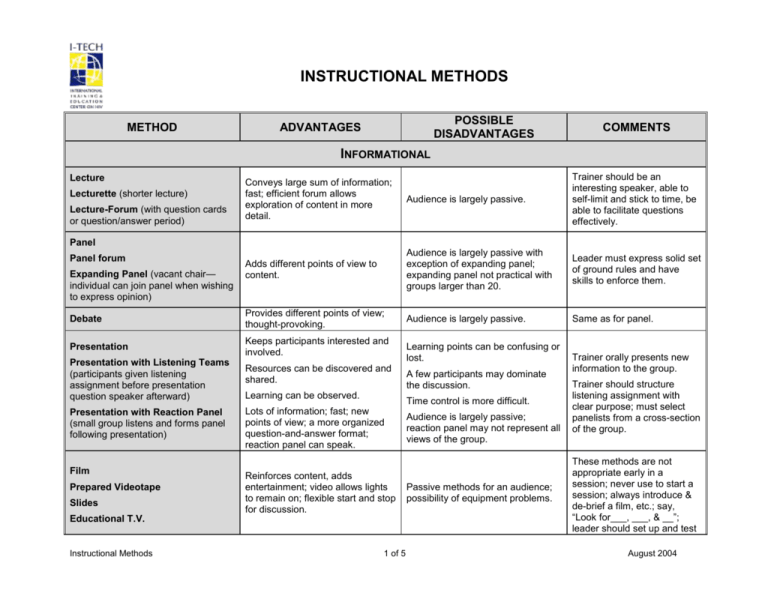
INSTRUCTIONAL METHODS METHOD POSSIBLE DISADVANTAGES ADVANTAGES COMMENTS INFORMATIONAL Conveys large sum of information; fast; efficient forum allows exploration of content in more detail. Audience is largely passive. Trainer should be an interesting speaker, able to self-limit and stick to time, be able to facilitate questions effectively. Adds different points of view to content. Audience is largely passive with exception of expanding panel; expanding panel not practical with groups larger than 20. Leader must express solid set of ground rules and have skills to enforce them. Debate Provides different points of view; thought-provoking. Audience is largely passive. Same as for panel. Presentation Keeps participants interested and involved. Lecture Lecturette (shorter lecture) Lecture-Forum (with question cards or question/answer period) Panel Panel forum Expanding Panel (vacant chair— individual can join panel when wishing to express opinion) Presentation with Listening Teams (participants given listening assignment before presentation question speaker afterward) Presentation with Reaction Panel (small group listens and forms panel following presentation) Film Prepared Videotape Slides Resources can be discovered and shared. Learning can be observed. A few participants may dominate the discussion. Time control is more difficult. Lots of information; fast; new points of view; a more organized question-and-answer format; reaction panel can speak. Reinforces content, adds entertainment; video allows lights to remain on; flexible start and stop for discussion. Educational T.V. Instructional Methods Learning points can be confusing or lost. 1 of 5 Audience is largely passive; reaction panel may not represent all views of the group. Passive methods for an audience; possibility of equipment problems. Trainer orally presents new information to the group. Trainer should structure listening assignment with clear purpose; must select panelists from a cross-section of the group. These methods are not appropriate early in a session; never use to start a session; always introduce & de-brief a film, etc.; say, “Look for___, ___, & __”; leader should set up and test August 2004 METHOD POSSIBLE DISADVANTAGES ADVANTAGES COMMENTS equipment before session; have adapter plug and extra bulbs. Keeps participants interested and involved. Group Discussion (of given topic) Buzz Groups (short, time-limited discussion on given subject) Brainstorming Resources can be discovered and shared. Learning can be observed. Learning points can be confusing or lost. A few participants may dominate the discussion. Time control is more difficult. Reading with Discussion or Report. Trainer should be able to give clear instructions and keep discussion on target. Main function is judging when to cut off discussion. Can get all participants involved in collecting a lot of information. The problem/issue must be clearly defined. Quickly generate ideas. Time control is more difficult. Good for problem-solving; quick change of pace; filler; allows all to participate; validates ideas of group. Need clear trigger questions and evaluation/discussion afterwards; somewhat over-used method; requires careful facilitation. For idea generation and creative group thinking; all participants present many ideas as rapidly as possible on a problem or issue. Then group organizes list into categories for further discussion. Material can be kept for later use. Insures consistency of information. Can be boring if used too long without interruption. Participants read at different paces. Engaging, active; provides a chance for in-depth insight and different perspectives. Instructional Methods Small group has a short time to discuss a topic or solve a problem Inexperienced leader may be unable to use format for attitudinal purposes. Participants are active; allows chance to hear other points of view; quieter people can express viewpoints and ideas. Saves time (trainees can read faster than trainer can talk). Reading (alone or aloud) Trainer divides large group into small groups; groups of 4–6 are most effective. Difficult to measure if people are learning. 2 of 5 Do not evaluate, criticize, omit, or discuss contributions until all are written; record in contributor’s own words; use another person to record if possible. Written material is used to present new information to participants Requires skill to select relevant material; reading skill by participants. August 2004 METHOD POSSIBLE DISADVANTAGES ADVANTAGES COMMENTS May require more reading/writing skills than participants have; leader may have to fill in after reports. ATTITUDINAL METHOD POSSIBLE DISADVANTAGES ADVANTAGES COMMENTS Role-play Mini-role-play (See Behavioral Methods.) (See Behavioral Methods.) (See Behavioral Methods.) Portraits (of self or others) Thought provoking; good for making thoughts and opinions more concrete, warm-up activity. Requires participant self-direction. Need to relate to relevant learning goals. Simulation Games (See Behavioral Methods.) (See Behavioral Methods.) (See Behavioral Methods.) Task Groups Sustained interaction allows quieter people to express themselves; validates participants. Time consuming; requires great degree of self-direction and group maturity. Keep groups small and diverse with sustained interaction and clear purpose. Pantomime Skits Engaging, active; good for warmup. Willingness and trust of group necessary. Need to provide direction and purpose; relate method to relevant goals. Playing Self “movie” Doodling BEHAVIORAL METHOD POSSIBLE DISADVANTAGES ADVANTAGES Requires preparation time. Helps retention. Role-Play Allows participants to practice new skills in a controlled environment. Mini-Role-Play Participants are actively involved. Observers can impact attitude and behavior. Instructional Methods 3 of 5 May be difficult to tailor to all situations. Needs sufficient class time for exercise completion and feedback Requires maturity and willingness of groups; requires trainer have COMMENTS Participants act out problemsolving situations similar to those they will encounter in their workplace. Trainer needs skill and understanding—must get people into roles, give directions, establish a climate August 2004 METHOD POSSIBLE DISADVANTAGES ADVANTAGES excellent facilitation skills. “Movie” (role-play assisted by feedback, “more__, or less __”) Simulation games Tape recording with playback Videotape recording with playback Case study Mini-case study (problem situations for small groups to analyze) Critical incident (small section of case stating most critical or dramatic moment) “In-basket” (form of case study— “Letters, memos” etc. given to participant for response) Demonstration with practice (by participants) Instructional Methods of trust. Trainer needs insight into how an activity may pose a threat to some individuals; ability to help group process & de-brief. Use in well-formed group. Can be structured into dyad, triad, and fishbowl. Useful in rehearsing new skills, behaviors. (Same as for role-play, intensive and time consuming.) Intense involvement; practice skills in problem solving and decisionmaking; competitive. Very concrete learning tool; participant involved in judging own performance. Competitive; requires a game and possibly a consultant to help facilitate; time consuming. Criteria must be clear; feedback and assessment based on specific behaviors; requires equipment. A package game requires prep time for the leader to learn the rules and directions. Trainer should establish purpose and performance criteria clearly. Information must be precise and kept up-to-date. Participants are given information about a situation and directed to come to a decision or solve a problem concerning the situation. Requires active participant involvement. Can simulate performance required after training. Needs sufficient class time for participants to complete the case. Learning can be observed. Opportunity to apply new knowledge; requires judgment; good assessment tool; participants active; chance to practice skills. Helps participant clarify and crystallize thoughts, opinions, values; opportunity to apply knowledge to “real” situation. Participants can become too interested in the case content. Case study must be relevant to learner’s needs and daily concerns. Requires writing skills; must be relevant to participant. Aids comprehension and retention. Demonstration COMMENTS Stimulates participants' interest. Must be accurate and relevant to participants. Can give participants model to follow. Written examples can require lengthy preparation time. 4 of 5 Trainer needs to have knowledge and skills to “solve” the problem; may need to design own studies; compare approaches of several groups and reinforce best solutions. Leader needs knowledge of participant’s daily concerns/needs; ability to critique responses. Participants are shown the correct steps for completing a task or are shown an example of a correctly completed task. August 2004 METHOD POSSIBLE DISADVANTAGES ADVANTAGES Allows for optional modeling of desired behavior/skill; can be active; good for learning simple skills. Skills practice lab (small participant groups practice together). Trainer demonstrations may be difficult for all participants to see well. Different points of view and feedback; participant active; good for translating information into skills. Method more effective if participants are active; feedback must follow immediately after practice. Group should have enough knowledge or insight to coach one another. COMMENTS Requires skill to model desired behavior; break procedure down into simple steps; ability to provide feedback. Act as a resource to groups. PLANNING METHOD Group discussion with decisionmaking regarding a new action Individual or group planning session with report Instructional Methods POSSIBLE DISADVANTAGES ADVANTAGES Validates maturity and needs of group members; members have best insight into their problems and needs on-the-job; group leaves session with practical, constructive and mutual goals; groups get ideas from one another. 5 of 5 Requires mature group that can self-direct and stay on task; time consuming. COMMENTS Leader serves as resource once directions are given. August 2004


